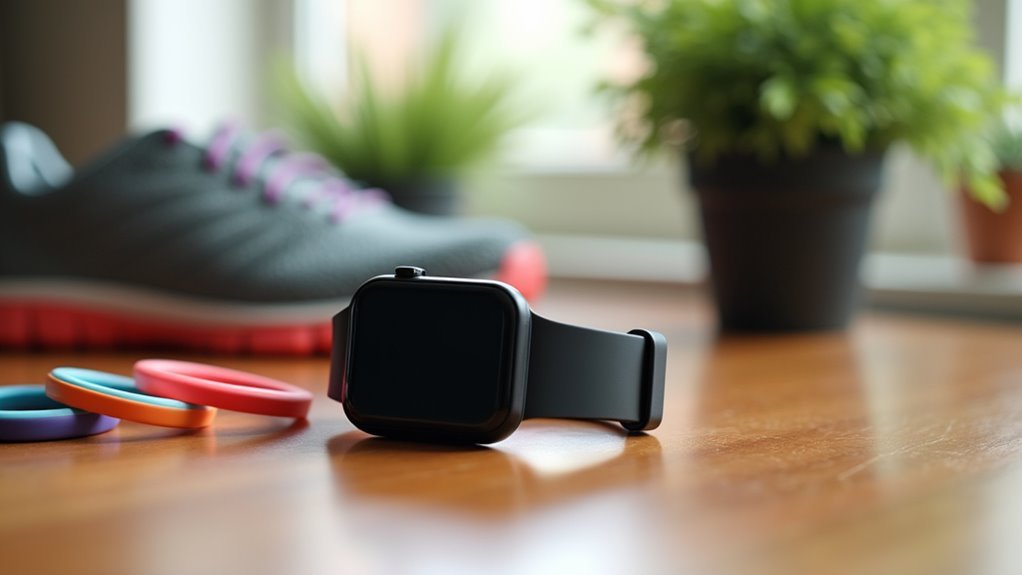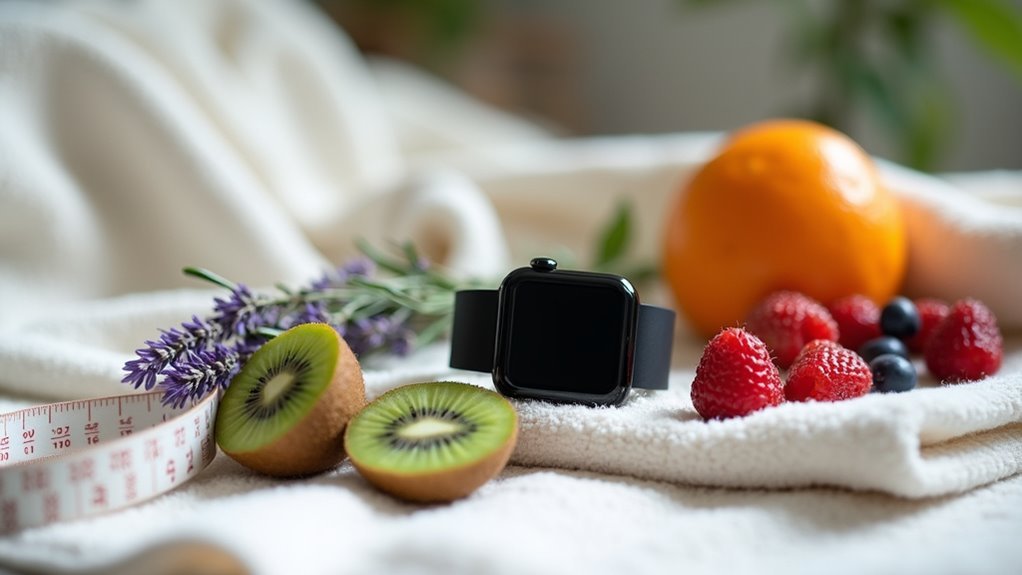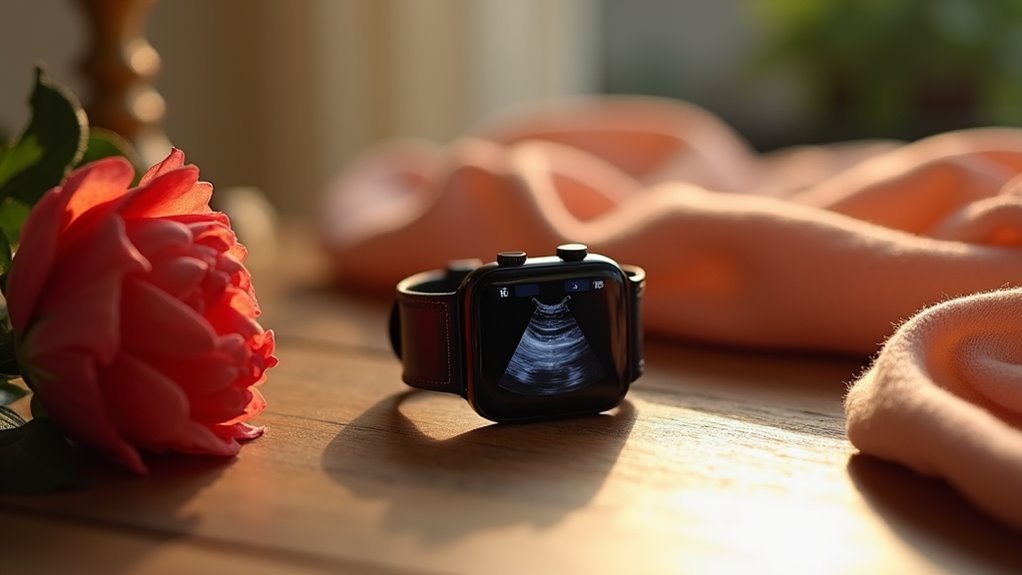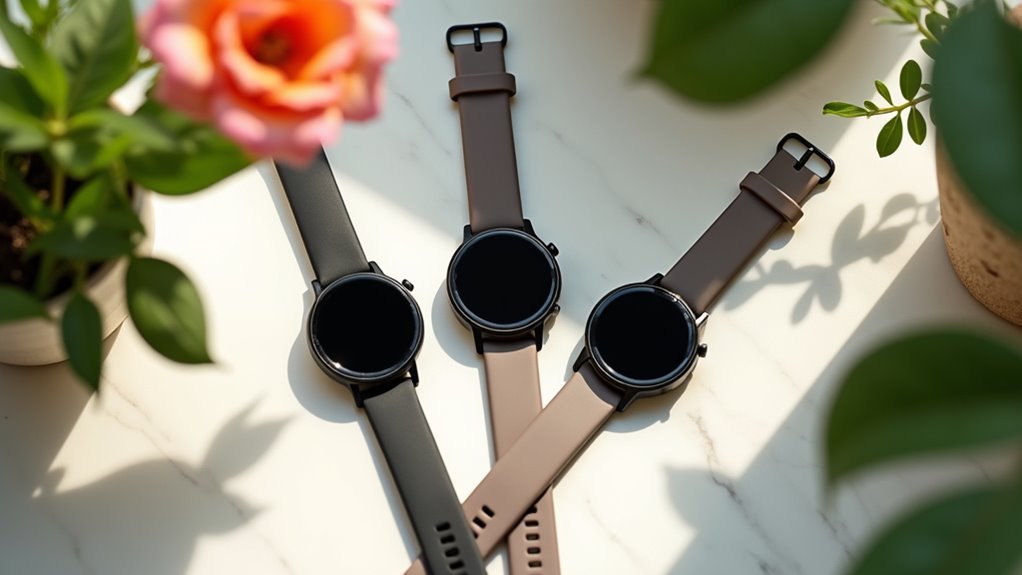Your fitness tracker monitors ten essential women’s health metrics including heart rate variability for cardiovascular risk assessment, menstrual cycle patterns with 62.7% accuracy for period predictions, sleep quality across different cycle phases, and ovulation timing that exceeds traditional calendar methods. It tracks stress levels through biometric analysis, body temperature fluctuations during hormonal changes, blood oxygen saturation, calorie burn variations throughout your cycle, and hydration needs affected by progesterone levels. These insights reveal how your body’s systems interconnect and optimize your health decisions.
Heart Rate Variability and Cardiovascular Health

While your fitness tracker displays a steady heart rate during rest, the tiny variations between each heartbeat reveal essential information about your cardiovascular health.
Heart Rate Variability (HRV) measures these time intervals between beats, reflecting how well your autonomic nervous system functions. As a woman, you’ll typically show lower SDNN values but higher HF power compared to men.
Women typically demonstrate distinct HRV patterns with lower SDNN measurements but elevated HF power values compared to their male counterparts.
Your HRV naturally declines with age, particularly between your twenties and thirties. Low HRV increases your risk of cardiovascular events by 32-45%, even without existing heart disease. Research shows that a 1% increase in SDNN correlates with approximately a 1% lower risk of fatal or non-fatal cardiovascular disease.
Your tracker can monitor basic HRV metrics, helping you identify early signs of cardiovascular stress. Understanding your HRV patterns empowers you to make informed decisions about your heart health and stress management.
Menstrual Cycle Length and Regularity Tracking
Modern fitness trackers transform menstrual cycle monitoring from guesswork into data-driven insights. Your wearable device uses body temperature fluctuations and heart rate changes to predict when your period will start, often alerting you six days in advance with 62.7% accuracy reported by most users.
These trackers monitor temperature increases during your luteal phase and analyze heart rate variations throughout different cycle phases. Advanced algorithms and machine learning continuously improve predictions based on your personal data patterns.
You can input additional information like mood and symptoms for thorough tracking. The technology helps you understand your body’s unique rhythms, though accuracy depends on consistent data input and individual cycle regularity. Devices that measure skin temperature readings taken during sleep provide more accurate tracking compared to those relying solely on user-input estimations.
While these insights enhance fertility planning and body awareness, remember that hormonal fluctuations, stress, lifestyle factors, and health conditions can affect cycle regularity.
Sleep Quality and Hormonal Recovery Patterns
Your fitness tracker transforms into a sleep laboratory each night, monitoring the intricate dance between rest and hormonal recovery that’s vital for women’s health. It tracks your sleep stages—light, deep, and REM—though accuracy varies between devices.
Your tracker analyzes sleep cycles using heart rate, movement, and other physiological data to calculate sleep efficiency.
Heart Rate Variability (HRV) becomes a significant metric, revealing how well you’re recovering from daily stressors. Since sleep directly impacts hormone regulation including insulin, growth hormone, and cortisol, your tracker provides recovery insights that inform lifestyle adjustments. Advanced trackers like the Oura Ring Gen 4 feature sleep staging algorithms that demonstrate accuracy comparable to clinical polysomnography tests.
While these devices can’t match clinical EEG monitoring, they offer valuable data about your sleep quality and its relationship to hormonal balance, helping you optimize your rest for better overall health.
Ovulation Prediction and Fertility Windows
Your fitness tracker can recognize your unique menstrual cycle patterns by monitoring physiological changes like body temperature and heart rate variability.
It’ll send you fertile window alerts when your body shows signs of approaching ovulation, helping you plan or prevent pregnancy naturally.
The device’s ovulation timing accuracy often surpasses traditional calendar methods, with some wearables detecting ovulation with over 96% accuracy compared to basic period apps that perform as poorly as 21%. Research shows that only 15% of women actually have a true 28-day cycle, despite 34% believing they do, which explains why standard calendar predictions often fail.
Cycle Pattern Recognition
Many fitness trackers now use sophisticated algorithms to detect patterns in your menstrual cycle data, predicting when you’re likely to ovulate and identifying your fertility windows.
These devices analyze your cycle length records, basal body temperature, heart rate variability, and cervical mucus tracking to recognize recurring patterns. Some trackers combine optical heart rate sensors with movement and rest patterns for enhanced predictions.
The algorithms become more personalized as they collect more of your individual cycle data. Machine learning models increasingly analyze this information, with advanced devices fusing accelerometer, optical heart rate, and temperature sensors. Lab work is still needed to determine the accuracy of these reproductive health tracking features across different fitness tracker models.
Most algorithms adapt to your variable cycle lengths and classify phases—follicular, ovulation, and luteal—using your historical data for improved accuracy over time.
Fertile Window Alerts
When fertility tracking apps struggle with prediction accuracy, fitness trackers offer a technological advantage through real-time physiological monitoring. Your wearable device tracks heart rate and body temperature fluctuations that indicate different menstrual cycle phases, providing more accurate ovulation detection than traditional calendar methods.
Smart rings like the Oura Ring have demonstrated high accuracy in detecting ovulation and predicting fertile windows. These devices excel particularly with irregular cycles, where calendar-based apps often fail. The algorithms analyze your physiological data continuously, outperforming traditional basal body temperature tracking.
Unlike most fertility apps that rely on cycle length assumptions, your fitness tracker uses real-time physiological changes. This technology offers improved reliability for fertility tracking while maintaining user-friendly accessibility, making ovulation prediction more precise and personalized. Recent research found that only four tools out of 53 fertility websites and apps accurately predicted the fertile window, highlighting the importance of choosing reliable tracking methods.
Ovulation Timing Accuracy
Although traditional calendar methods remain popular for tracking ovulation, they fall short with an average error of ±3.44 days compared to the remarkable 96.4% accuracy achieved by physiological monitoring devices like the Oura Ring.
You’ll find that app-based methods perform even worse, delivering only 21% accuracy in ovulation prediction.
Your fitness tracker’s physiological approach monitors real-time temperature changes and other biomarkers, maintaining ±1.26 days average error.
This precision proves especially valuable if you have irregular cycles, where calendar methods become unreliable.
Unlike manual basal body temperature tracking that requires daily effort and consistency, wearable devices automatically collect data while you sleep.
You’re getting continuous insights into your fertility patterns without the guesswork, making ovulation timing considerably more manageable and accurate. The validation research included 964 Oura members across various age groups and cycle patterns to ensure comprehensive accuracy testing.
Stress Level Monitoring Through Biometric Data
Your fitness tracker monitors stress through heart rate variability analysis, measuring the subtle timing differences between each heartbeat to assess your autonomic nervous system’s response to daily pressures.
When you’re stressed, your device detects physical indicators like elevated heart rate, reduced HRV, and changes in skin conductance that signal your body’s fight-or-flight response.
These biometric measurements provide real-time insights into how work deadlines, relationship challenges, or hormonal fluctuations affect your stress levels throughout the day. Advanced devices use motion sensors to differentiate between physical exertion from exercise and actual psychological stress responses.
Heart Rate Variability Analysis
Heart rate variability (HRV) represents one of the most sophisticated biometric measurements your fitness tracker can capture, revealing the subtle timing differences between consecutive heartbeats that reflect your autonomic nervous system’s function.
Higher HRV typically indicates better health and stress resilience, while lower values often signal elevated stress levels or declining wellness. Tracking HRV can help measure physiological changes during therapeutic sessions or wellness interventions.
Your device monitors HRV trends to detect early warning signs of illness, poor sleep quality, or mental health changes.
Unlike heart rate alone, HRV provides personalized insights by comparing your current readings to your individual baseline rather than population averages.
Popular devices like Apple Watch, Fitbit, and Garmin integrate HRV data with health apps, offering thorough analysis that helps you optimize recovery, prevent overtraining, and make informed decisions about your daily activities and stress management strategies.
Physical Stress Indicators
Modern fitness trackers extend beyond heart rate variability to monitor a thorough array of physical stress indicators through multiple biometric sensors. Your device calculates stress scores by comparing current heart rate data to your baseline measurements, detecting deviations that signal elevated stress levels.
Advanced trackers like Fitbit incorporate electrodermal activity sensors that measure sweat changes linked to stress responses. These EDA sensors work alongside heart rate monitoring to provide extensive stress assessment throughout your day.
Your tracker’s algorithms distinguish between physical exertion and actual stress by analyzing motion data and activity patterns. Sleep quality metrics further enhance stress detection, as poor rest correlates with increased stress levels. Some devices can also measure cortisol levels through advanced biochemical sensors, providing direct hormonal indicators of your body’s stress response.
Real-time monitoring enables immediate stress management through breathing exercises and personalized notifications when your device identifies concerning patterns.
Daily Activity and Steps for Reproductive Health

While fitness trackers primarily gained popularity for counting steps and calories, they’ve evolved into powerful tools for monitoring reproductive health through daily activity patterns. Your step count reveals vital insights about hormone balance, as regular movement helps stabilize menstrual cycles and reduce stress that disrupts reproductive wellness.
Daily activity tracking enables you to adapt exercise routines to different menstrual phases, optimizing your workouts when hormonal sensitivity varies. Weight management through consistent movement supports fertility, since both obesity and being underweight can affect reproductive health. Your tracker’s cardiovascular benefits from walking also enhance overall reproductive well-being.
Modern health apps integrate step tracking with cycle monitoring, creating extensive reproductive health profiles. This data helps you plan exercise that aligns with your body’s natural rhythms while maintaining the hormonal regulation essential for fertility. However, users should understand that menstrual tracking apps show significant discrepancies in their predictions and should be considered estimates rather than precise medical information.
Body Temperature Changes and Cycle Phases
Your fitness tracker can now monitor subtle body temperature fluctuations that reveal vital information about your menstrual cycle phases.
These devices use advanced sensors to detect the characteristic temperature rise that occurs after ovulation, helping you identify fertile windows with greater precision than traditional methods. Modern wearable devices like Oura Ring or Apple Watch offer alternative measurement methods for tracking basal body temperature throughout your cycle.
Temperature Tracking Technology
Because your body temperature naturally fluctuates throughout your menstrual cycle, fitness trackers have emerged as valuable tools for monitoring these subtle but significant changes.
Modern devices like the Oura Ring use advanced sensor placement on your finger to achieve high precision in temperature readings. The CORE sensor employs heat flux measurement technology, calculating thermal energy transfer between your body and environment through AI-powered algorithms that deliver medical-grade accuracy.
These wearables continuously monitor your basal body temperature, which typically increases during your luteal phase. This data helps you identify fertility windows and potential hormonal imbalances. The CORE device offers continuous transmission for up to 6 days, ensuring consistent tracking throughout your cycle phases.
However, sensor placement affects accuracy—finger-based devices generally outperform wrist-worn trackers. Environmental factors like cold weather can also impact readings, though AI processing helps compensate for these variables, providing you with reliable health insights.
Ovulation Detection Methods
Multiple detection methods work together to pinpoint ovulation with greater accuracy than any single approach alone. Your fitness tracker combines temperature monitoring with additional physiological signals to create a thorough picture of your cycle.
Modern wearables enhance accuracy by incorporating:
- Hormonal indicators – LH surge detection through test strips confirms peak fertility timing, while progesterone testing validates ovulation occurred.
- Cervical mucus patterns – Changes in consistency and abundance provide real-time fertile window identification when estrogen peaks.
- Multi-parameter algorithms – Heart rate variability, respiratory rate, and sleep patterns fluctuate with hormonal changes throughout your cycle.
These integrated approaches reduce prediction errors from approximately 6.6 days with calendar methods to just 1.5 days, making them especially valuable if you have irregular cycles. Some devices provide overnight temperature collection while worn on the upper arm during sleep, eliminating the need for morning temperature checks that can be disrupted by lifestyle factors.
Cycle Phase Predictions
When your fitness tracker detects subtle temperature shifts throughout your cycle, it’s mapping the hormonal fluctuations that drive each phase from menstruation through ovulation and beyond. Your device uses algorithmic predictions combined with biometric data like skin temperature to forecast what’s coming next in your cycle.
| Cycle Phase | Temperature Pattern | Tracker Prediction |
|---|---|---|
| Menstrual | Baseline low | Cycle start confirmation |
| Ovulation | Sharp rise | Fertile window alert |
| Luteal | Elevated plateau | Next period countdown |
However, you shouldn’t rely solely on these predictions for fertility planning. Studies show prediction fail rates of 7.2–8.3% when apps lack physiological evidence. Your cycle’s natural variability can affect accuracy, so consider using multiple tracking methods for better insights into your reproductive health patterns. Many apps also lack transparency in algorithms, making it difficult to understand how predictions are generated for your specific cycle patterns.
Blood Oxygen Saturation During Different Cycle Stages
While your fitness tracker continuously monitors blood oxygen saturation (SpO₂) throughout your menstrual cycle, the variations you’ll observe are typically subtle and remain within normal physiological ranges of 94% to 99%.
Your SpO₂ readings remain remarkably stable between follicular and luteal phases, though hormonal changes create interesting respiratory adaptations.
During your luteal phase, progesterone increases your breathing rate and ventilatory drive, leading to more efficient carbon dioxide elimination. However, this enhanced respiratory response doesn’t translate to dramatic SpO₂ changes in healthy women.
Key patterns you might notice include:
- Baseline consistency – Your SpO₂ stays within normal ranges regardless of cycle phase
- Minor fluctuations – Small daily variations occur but aren’t specifically tied to hormonal changes
- Enhanced ventilation – Increased breathing efficiency during luteal phase without significant SpO₂ impact
Research shows that premenopausal women demonstrate better oxygenation compared to postmenopausal women, particularly in challenging environments where oxygen availability is reduced.
Calorie Burn Rates Throughout Monthly Cycles
Your fitness tracker’s calorie burn estimates fluctuate throughout your menstrual cycle, though the changes are more modest than you might expect.
During your luteal phase, hormonal fluctuations can increase your metabolic rate by roughly 8%, translating to about 164 extra calories daily. However, your tracker likely doesn’t account for these cycle-specific variations.
Your fitness tracker misses an important detail: luteal phase hormones naturally boost your metabolism by 8%, burning an extra 164 calories daily.
Your energy intake naturally rises during the luteal phase, averaging 2259 calories compared to 1730 during the follicular phase. This increase ranges from 90 to 529 calories daily.
Menstruation itself doesn’t greatly boost calorie burn, and exercise won’t burn more calories simply because you’re menstruating. Individual factors like diet and activity level influence your metabolism more than cycle phases alone, making your tracker’s general estimates useful baseline measurements. Regular menstruation synchronizes with healthy metabolism, while significant metabolic changes can disrupt reproductive hormone production.
Hydration Needs and Hormonal Fluctuation Tracking
Since hormonal fluctuations throughout your menstrual cycle affect more than just calorie burn, they also influence how much water you need daily.
During the luteal phase, elevated progesterone increases your resting heart rate and body temperature, which can boost fluid requirements through increased sweating and thermal regulation demands.
Your fitness tracker’s ability to monitor these physiological changes makes it a valuable tool for optimizing hydration:
- Temperature tracking – Elevated body temperature during mid to late luteal phase indicates increased fluid needs
- Heart rate monitoring – Higher resting heart rates correlate with hormonal shifts affecting hydration status
- Cycle phase identification – Combined metrics help predict when you’ll need additional water intake
This physiological monitoring lets you adjust your hydration strategy proactively rather than waiting for thirst signals.
Frequently Asked Questions
Can Fitness Trackers Detect Early Pregnancy Before a Missed Period?
You can’t rely on fitness trackers to definitively detect pregnancy before a missed period, though they may notice temperature changes or heart rate variations that could suggest early pregnancy.
Do Fitness Trackers Work Accurately During Menopause and Hormonal Changes?
You’ll find fitness trackers moderately accurate during menopause, effectively monitoring sleep patterns, heart rate, and temperature changes. However, they can’t capture all hormonal symptom nuances and often require manual input for thorough tracking.
Which Fitness Tracker Brands Offer the Most Comprehensive Women’s Health Features?
Apple Watch and Fitbit lead with thorough menstrual tracking, fertility insights, and pregnancy modes. Garmin excels in stress recovery analytics, while Samsung offers advanced sleep monitoring. You’ll find Huawei provides excellent value with stylish designs.
Are Fitness Tracker Health Predictions Reliable Enough to Replace Medical Consultations?
You shouldn’t replace medical consultations with fitness tracker predictions. While they’re moderately accurate at 67%, they lack extensive diagnostic capability. Use them as supplementary data, but always seek professional medical evaluation for health concerns.
How Do Birth Control Pills Affect Fitness Tracker Cycle Predictions?
Birth control pills reduce your cycle’s natural variability, making some aspects predictable but potentially confusing fitness trackers that rely on hormonal fluctuations to predict ovulation and cycle timing accurately.




Leave a Reply